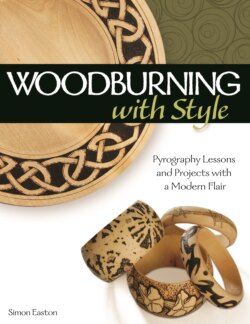Читать книгу Woodburning with Style - Simon Easton - Страница 15
На сайте Литреса книга снята с продажи.
Additional Equipment
ОглавлениеAs well as your pyrography machine of choice, the following other tools or items of equipment may prove useful to you while working:
• A range of standard pencils for drawing designs onto your material. You may prefer to use automatic or mechanical pencils with refillable lead. The delicate nature of the line that these provide can be more suited to accurate work, and they are also less prone to smudge. If you choose to use a traditional pencil, you will need a good quality pencil sharpener to keep your pencils in good condition.
• A good eraser for correcting the inevitable mistakes that will occur! I tend to use a soft eraser as it is less likely to mark or damage the surface you are working on.
• A range of sandpapers to assist with correcting more serious mistakes and for the preparation of wooden surfaces.
• A ruler and set of compasses to assist in marking up designs. These are particularly useful for accuracy when working with borders or other geometric shapes.
• A set of geometric stencils can be very useful if you repeatedly use simple shapes such as circles or ovals.
• An appropriate screwdriver and set of pliers for changing the nibs or wires on your pyrography machine.
• A selection of jeweler’s needle files, which can be used to create your own shaped nibs for hot wire machines.
The basic essentials in terms of drawing equipment for any new pyrographer (from left to right): a steel ruler, an eraser, a selection of pencils, a craft scalpel, a pair of compasses, an automatic (or mechanical) pencil, tracing paper, and masking tape.
Geometric stencils can be very handy for drawing small shapes such as circles or ovals.
You will also find the following tools very useful for preparing and maintaining materials and equipment (from left to right): a selection of sandpaper (from coarse to fine), a pair of pliers, a set of jeweler’s needle files, and a flat-headed screwdriver.
You can purchase protective mats to protect your work surface from the heat of the pyrography pen.
• A protective board to avoid damage to your table or desk. I suggest heavy duty cardboard or a solid piece of plywood. This can be a scrap piece of material that you can replace once it becomes too pitted or grubby for further use. You can also purchase a heat-resistant mat designed to cope with extremely high temperatures.
• Sheets of tracing paper for transferring designs onto your material. You can use graphite paper if you wish, but it is a little more expensive.
• A roll of masking tape for keeping the tracing paper or stencil in place when you are transferring designs onto your materials. Also use it to mask off areas you wish to keep clean or protect in some way while you are working.
• A good craft knife or scalpel for correcting errors made by burning a surface too much.
• A supply of steel wool for cleaning pyrography nibs after prolonged periods of burning. You can also use an old craft knife blade to remove dirty deposits from the pen nibs.
• A small anvil and hammer, if you really enjoy making and shaping your own nibs. They can be used to flatten wire nibs into fine flat edges or delicate points.
• A supply of soft cloths for wiping dust and grit away from your working surfaces, as well as for applying finishing treatments.
• A selection of different oils or varnishes for finishing your work.
• An electric fan to remove the smoke as you burn.
• A good electric light so you can see clearly as you work.
We will cover other materials and media that you can combine with your pyrography designs, such as paints, colored pencils, and other accessories. These are not essential as you learn the basics of pyrography, but they do provide the scope for broadening the potential of your work.
